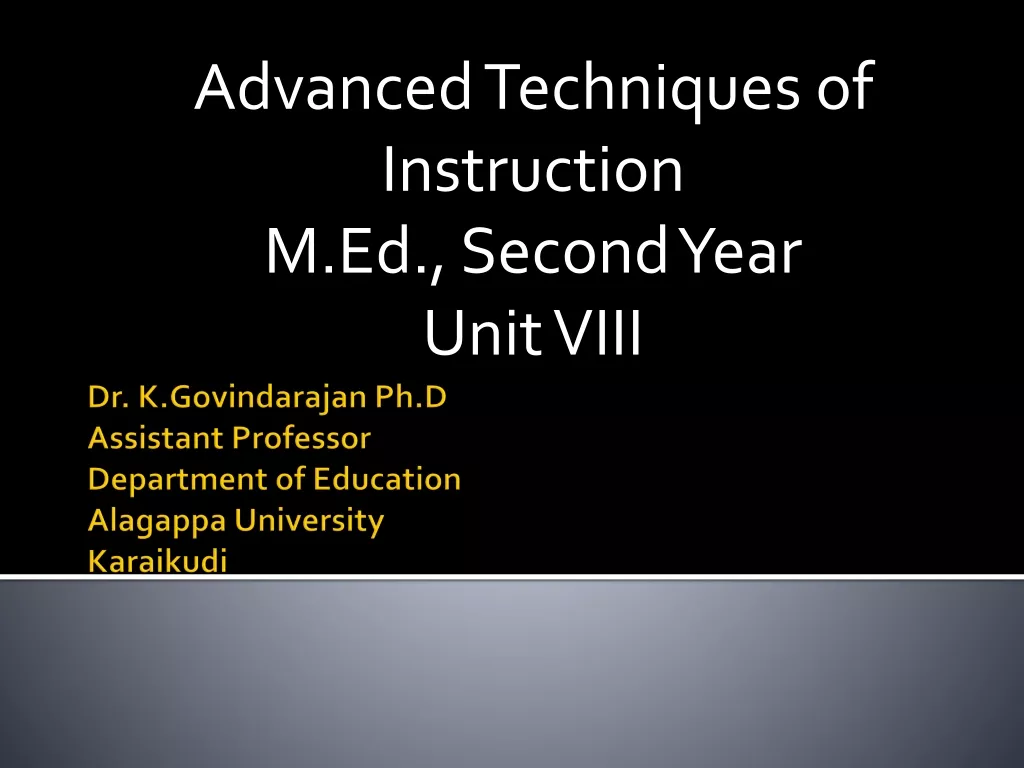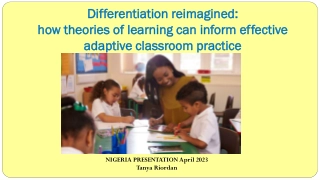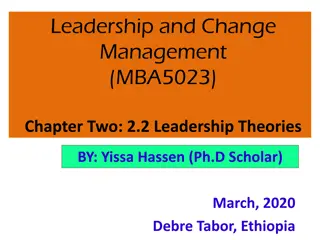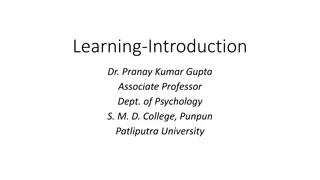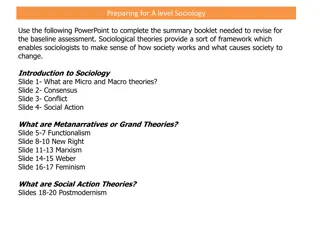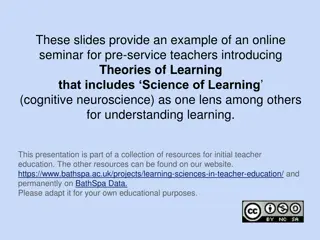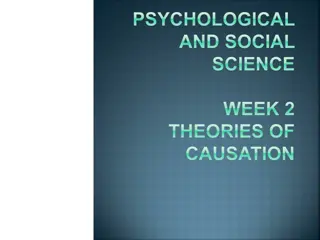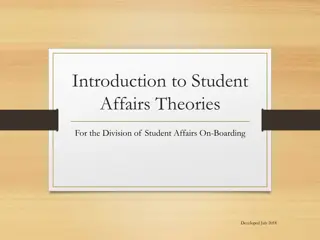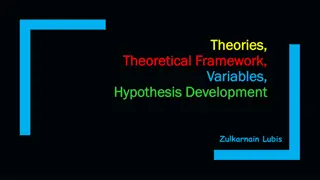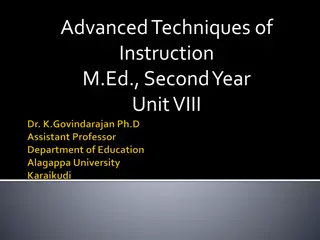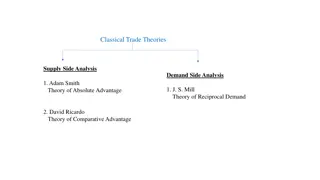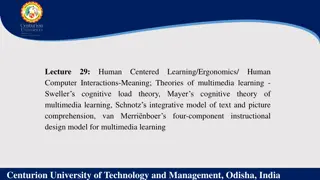Learning Theories and Design Strategies
Delve into the realms of constructivism, cognitivism, and behaviorism as they shape learning theories. Explore how design strategies like backwards design and the nine events of instruction enhance the learning experience. Discover the value of each theory for learners and adapt lesson plans to accommodate different educational philosophies.
Download Presentation

Please find below an Image/Link to download the presentation.
The content on the website is provided AS IS for your information and personal use only. It may not be sold, licensed, or shared on other websites without obtaining consent from the author.If you encounter any issues during the download, it is possible that the publisher has removed the file from their server.
You are allowed to download the files provided on this website for personal or commercial use, subject to the condition that they are used lawfully. All files are the property of their respective owners.
The content on the website is provided AS IS for your information and personal use only. It may not be sold, licensed, or shared on other websites without obtaining consent from the author.
E N D
Presentation Transcript
1 JOT2 Learning & Design Theories LOIS KENT JUNE 7, 2015
2 Contents Learning Theories Design Theories Constructivism Backwards Design (Grant Wiggins and Jay McTighe) Cognitivism The Nine Events of Instruction (Robert Gagne) Behaviorism Teaching for Understanding (the Harvard model)
3 Task A: Learning Theories & Learners CONSTRUCTIVISM COGNITIVISM BEHAVIORISM
4 Value of Constructivism for Learners Learner-centric Facilitated learning Experiential learning Incorporates students experiences, thoughts and emotions Personalized learning outcomes Results in deep understanding of topic High retention
5 Value of Cognitivism for Learners Directed learning (expert/teacher as a resource) Clear results to achieve Enhanced learning experience due to brain-based learning Builds on students previous knowledge Student actively acquires knowledge Good retention due to building on existing knowledge or skills
6 Value of Behaviorism for Learners Directed learning (expert/teacher as a resource) Clear results to achieve Motivating rewards and positive reinforcement Helpful for knowledge or skills that require memorization or automated reactions
7 Task B: Learning Theory Used LESSON PLAN NO REST FOR THE WEARY
8 Constructionism/Cognitivism Lesson Plan No Rest for the Weary? (refer to handout) Constructionist Facilitated learning Sleep logs and journals (develop goals internally) Group discussions (to express personal opinions) Research projects Proposal to school board Cognitivist Directed learning Article with expert opinion (external goal) Group discussions (to reflect, not dispute) (Image of sleeping student, 2011) (Cutraro & Ojalvo, 2011)
9 Task C: Adaptation of Lesson Plan LESSON PLAN NO REST FOR THE WEARY
10 Behaviorism Adapted Lesson Plan No Rest for the Weary? (refer to handout) Behaviorist adaptation Directed learning External authority Explicit behaviors (bedtimes, hours of sleep, bedtime routines, etc.) Positive reinforcement for exhibiting desired behaviors (Image of sleeping student, 2011) (Cutraro & Ojalvo, 2011)
11 Task D: Lesson Plan Discussion LESSON PLAN NO REST FOR THE WEARY
12 Preferred Learning Theory Lesson Plan No Rest for the Weary? (refer to handout) Preferred Learning Theory Constructivism Student-centric Deeper understanding Personalized results Higher chance of long-term impact Able to re-assess in the future (Image of sleeping student, 2011) (Cutraro & Ojalvo, 2011)
13 Task E: Effective Instruction Through the Use of Design Theories
14 Value of Instructional Design Theories To enhance learning outcomes To match learning objectives To adapt to instructional and performance contexts To improve retention To meet learner needs use Why theory ? Instructional Design
15 Task F: Design Theories & Learners BACKWARD DESIGN (WIGGINS) NINE EVENTS OF INSTRUCTION (GAGNE) TEACHING FOR UNDERSTANDING (HARVARD)
16 Backward Design (Wiggins) Identify desired results of instruction Identify acceptable assessments Plan learning experiences and activities
17 Backward Design (Wiggins) Strengths Limitations Clear goals Learner knows when success achieved All instruction and assessment clearly tied to goals Connects to learner s existing knowledge, increases retention Teacher-centric Does not allow for multiple truths/goals Does not allow for personally relevant or differentiated outcomes Does not inspire higher level cognitive processes
18 Nine Events of Instruction (Gagne)
19 Nine Events of Instruction (Gagne) Strengths Limitations Brain-based design stimulates learning Strong structure appeals to many students Success criteria is clear Excellent for memorization, psychomotor skills, and basic to mid-level cognitive tasks Teacher-centric Does not allow for personally differentiated outcomes Cannot support complex learning objectives (e.g., decision making) Overly structured approach may lead to disengagement
20 Teaching for Understanding (Harvard) Generative topic Understanding goals Demonstrate understanding Ongoing assessment
21 Teaching for Understanding (Harvard) Strengths Limitations Student-centered Allows for multiple potential outcomes Personalized results Cross-subject knowledge development High retention Overly complex for simple tasks Only works with generative topics Lack of definitive objective is challenging for some learners Limits availability of teacher support
22 Task G: Most Suitable Design Process LESSON PLAN NO REST FOR THE WEARY
23 Preferred Design Process Lesson Plan No Rest for the Weary? (refer to handout) Preferred Design Process Teaching for Understanding Student-centric Development of personalized sleep habits Likelier chance of long-term improvement Understanding stretches across multiple areas of study Able to replicate experiences to teach others (Image of sleeping student, 2011) (Cutraro & Ojalvo, 2011)
24 Summary Learning Theories Design Theories Constructivism Backwards Design (Grant Wiggins and Jay McTighe) Cognitivism The Nine Events of Instruction (Robert Gagne) Behaviorism Teaching for Understanding (the Harvard model)
25 Resources Cutraro, J. & Ojalvo, H. (2011, May 25). No Rest for the Weary? Analyzing Sleep Habits. The New York Times. Retrieved from http://learning.blogs.nytimes.com/2011/05/25/no-rest-for-the-weary-analyzing-sleep-habits/?_r=1 [Image of sleeping student] (2011). Retrieved from: Retrieved from: http://learning.blogs.nytimes.com/2011/05/25/no- rest-for-the-weary-analyzing-sleep-habits/?_r=1 Note: All other graphics used were generated with PowerPoint tools (i.e., Shapes or Smart Art) and were created by the author of this document, Lois Kent.


